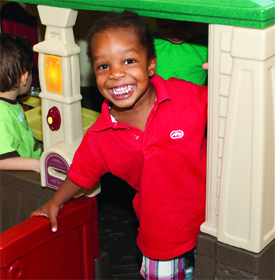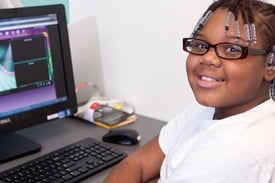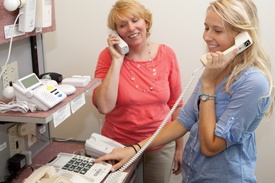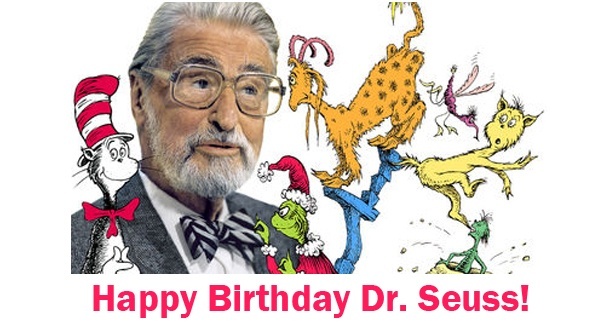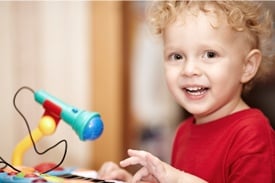As of July 2004, all babies born in the state of Ohio receive a free hearing screening before they go home from the hospital. The Universal Newborn Hearing Screening (UNHS) legislation has been helpful in detecting hearing loss sooner and allowing families to begin helping their babies earlier. Typically, hearing is tested at birth, and, if it’s normal, is not tested again until approaching age 4. This usually takes place on a visit to the pediatrician. Hearing is screened again when the child enters school. Many schools then alternate between vision and hearing screenings during the school-age years.
Infant/Toddler Hearing Checklist
Tags: Speech, Audiology, Communication, Hearing, Hearing Loss Prevention, Support
Assistive Listening Devices Can Boost Your Hearing
When your hearing aids do not provide enough help in certain environments, or if you don’t wear hearing aids but need help hearing only in certain situations, you may want to consider an assistive or alerting device. Discuss with your audiologist which devices might be helpful to you. At CHSC, we offer a variety of devices and can you determine which is right for you.
Tags: Audiology, Hearing Aids, Communication, Hearing, Hearing Loss
How Hearing Works
The outer ear is what most people consider “the ear.” It consists of a flap of skin/cartilage (called the pinna or auricle) on the outside of the head. It collects sound and directs it into the ear canal. The ear canal is a closed tube with hairs and “wax glands” in the outer portion. Our ear canal is self-cleaning. The wax glands produce wax, or cerumen, and the tiny hairs push the wax out of our ears. As the wax moves out of the ear, it cleans the ear canal and keeps unwanted critters, such as insects, out of the ear. At the end of the ear canal is the eardrum, or tympanic membrane. When air moves it creates vibrations. These sound vibrations are collected by the pinna and directed into the ear canal, to the eardrum, causing it to vibrate just like the head of a drum when you hit it with a drumstick. When an audiologist or physician looks into a healthy, unobstructed ear with an otoscope, s/he can see the outer surface of the eardrum.
Tags: Audiology, Communication, Hearing, Hearing Loss
Hearing Loss: Be Your Own Self-Advocate
Self-advocacy encompasses learning how to speak up for yourself. It involves surrounding yourself with individuals that will support you in your journey, being knowledgeable regarding your rights, and being able to voice your rights to others. Advocating for yourself will not only lead to success in life, but it will help break down barriers and educate others about hearing loss. Living with a disability presents challenges, but fear not - with the appropriate support systems, strategies, and knowledge, you can learn to improve your quality of life.
Tags: Audiology, Communication, Hearing, Support, Hearing Loss
7 Ways to Help the Child Who Stutters
Tags: Speech, Language, Communication, Stuttering
Technology & Tips for Improved Telephone Communication for People with Hearing Loss
For people with hearing loss, hearing on the telephone is often a struggle; whether conversing with friends or family, arranging a job interview, contacting a company’s customer service department, or scheduling a medical appointment.
Tags: Hearing Aid, Audiology, Hearing Aids, Communication, Hearing, Hearing Loss Prevention, Hard of Hearing, Hearing Loss
Read Across America Day - March 2
The National Education Association (NEA) Read Across America Day is an annual reading motivation and awareness program that calls for every child in every community to celebrate reading on March 2, the birthday of beloved children's author Dr. Seuss.
Tags: Speech, Language, Communication, reading, literacy, Wilson Reading Program, Learning
World Hearing Day at CHSC
World Hearing Day, formally known as International Ear Care Day, is celebrated every year on March 3rd. The World Health Organization started this day in 2007 to promote better hearing health care through themes. The 2018 theme is “Hear the future” - drawing attention to the anticipated increase in the number of people with hearing loss around the world in the coming decades. It will focus on three strategies (Prevention, Identification, Treatment) to stem the rise and outline steps to ensure access to the necessary rehabilitation services and communication tools and products for people with hearing loss.
Tags: Hearing Aid, Audiology, Hearing Aids, Communication, Hearing, Hearing Loss Prevention, Hard of Hearing, Hearing Loss
My Baby Needs Hearing Aids – Now What?
My beautiful baby is born and the feelings of joy are immense. Everything is brand new and a little overwhelming. The routine hearing screening at the hospital is performed. Wait. What? My baby needs more testing? But that doesn’t make sense! We have no history of hearing loss in the family and my baby is "healthy.” I do as suggested and schedule a full diagnostic test. The results show a permanent hearing loss. The audiologist is recommending hearing aids.
Tags: Hearing Aid, Hearing Aids, Communication, Hearing, Hard of Hearing, Hearing Loss
Your Child’s Speech & Language Development: Birth to 5 Years
What to Look for at Various Ages
Birth to 6 Months
- Responds to sounds (startles, turns head).
- Quiets to familiar voices.
- By 6 months, responds to name being called.
- Vocalizes when talked to.
- Begins to coo.
Tags: Speech, Language, Communication




